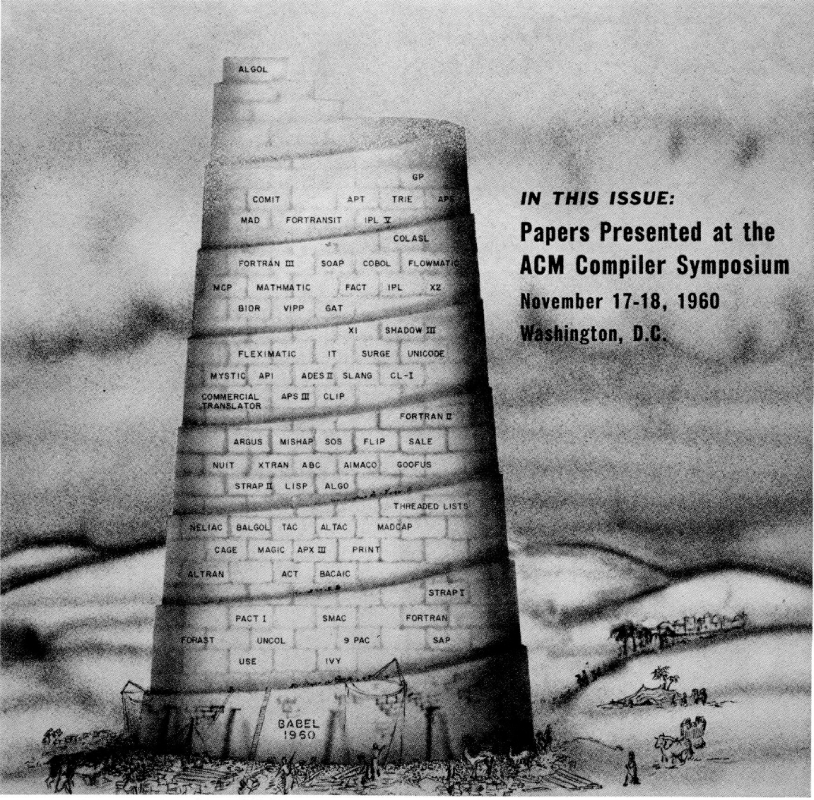Commercial Translator(ID:6502/com013)
IBM decided to release COMTRAN with a full name instead
Related languages
| COMTRAN | => | Commercial Translator | Renaming |
References:

in [ACM] CACM 4(01) (Jan 1961) view details
in [ACM] CACM 4(01) (Jan 1961) view details
The "commercial" papers are mostly devoted to COBOL. There is a detailed description, by Jean E. Sammet, and a paper of general views on COBOL, by the same author, also "A critical discussion of COBOL," by several members of the British Computer Society. A long paper by R. F. Clippinger describes FACT, a commercial language developed for the HONEYWELL 800, and compares it in considerable detail with COBOL and IBM Commercial Translator, aiming to show the superiority of FACT over these languages. "The growth of a commercial programming language" by H. D. Baeker describes SEAL, a language developed for the Stantec Data Processing System, and again aims to demonstrate its superiority over COBOL.
in The Computer Bulletin June 1962 view details
in [ACM] CACM 6(03) (Mar 1963) view details
Aims
What do we want from these Automatic Programming Languages? This is a more difficult question to answer than appears on the surface as more than one participant in the recent Conference of this title made clear. Two aims are paramount: to make the writing of computer programs easier and to bring about compatibility of use between the computers themselves. Towards the close of the Proceedings one speaker ventured that we were nowhere near achieving the second nor, indeed, if COBOL were to be extended any further, to achieving the first.
These aims can be amplified. Easier writing of programs implies that they will be written in less, perhaps in much less, time, that people unskilled in the use of machine language will still be able to write programs for computers after a minimum of training, that programs will be written in a language more easily read and followed, even by those completely unversed in the computer art, such as business administrators, that even the skilled in this field will be relieved of the tedium of writing involved machine language programs, time-consuming and prone to error as this process is. Compatibility of use will permit a ready exchange of programs and applications between installations and even of programmers themselves (if this is an advantage!), for the preparation of programs will tend to be more standardised as well as simplified. Ultimately, to be complete, this compatibility implies one universal language which can be implemented for all digital computers.
Extract: COMMERCIAL TRANSLATOR
COMMERCIAL TRANSLATOR
Some other languages were also mentioned in passing to complete the picture of the present situation. In addition to FORTRAN for scientific work, IBM also produced a business language, the COMMERCIAL TRANSLATOR, which has been used with IBM 705, 7070 and 7090. Simple and elegant, with an excellent manual (not always true of other languages) it has, for once, adequate means of defining new functions but it also has the disadvantage of having no means of defining variable length fields. FILECODE, a Ferranti language for PEGASUS and SIRIUS, has the distinction of being the first commercial compiler to work in the UK. Like Language H for similar size machines, it is primitive, but it does work and it has good facilities for data description.
in The Computer Bulletin September 1962 view details
in Goodman, Richard (ed) "Annual Review in Automatic Programming" (3) 1963 Pergamon Press, Oxford view details
in ACM Computing Reviews 5(06) November-December 1964 view details
in [ACM] CACM 15(06) (June 1972) view details
in IBM Journal of Research and Development, 25(5), September 1981 25th anniversary issue view details
The author is eminently qualified to have written this paper. She is a long-time employee of IBM, and has written many papers and a definitive book on the development of programming languages. Her account of the contributions of IBM to the development of programming languages is itself a contribution to the subject.
in IBM Journal of Research and Development, 25(5), September 1981 25th anniversary issue view details